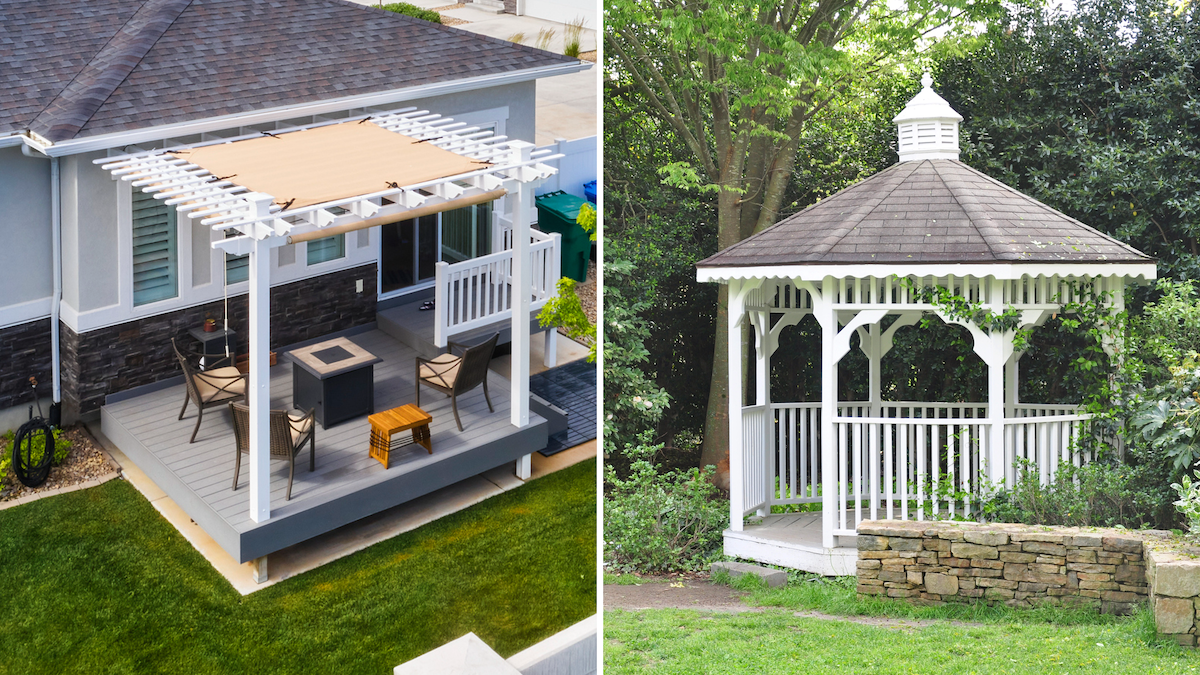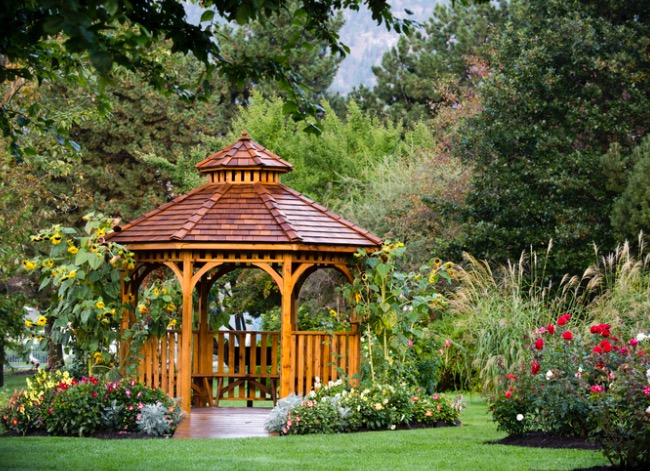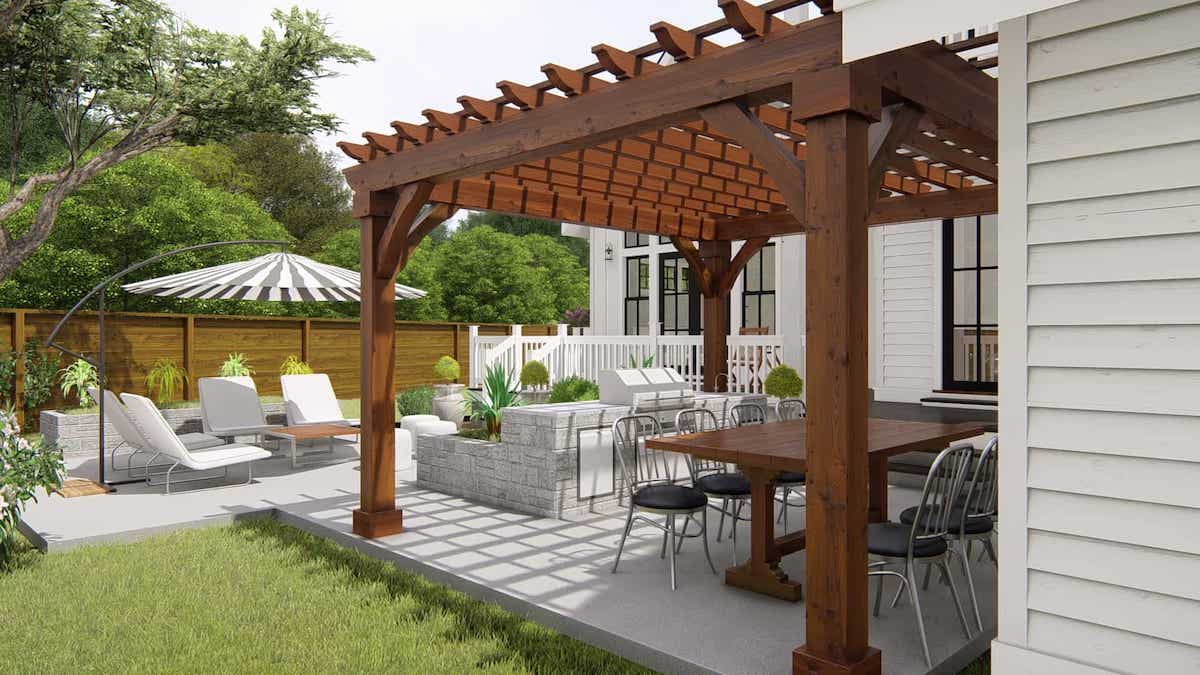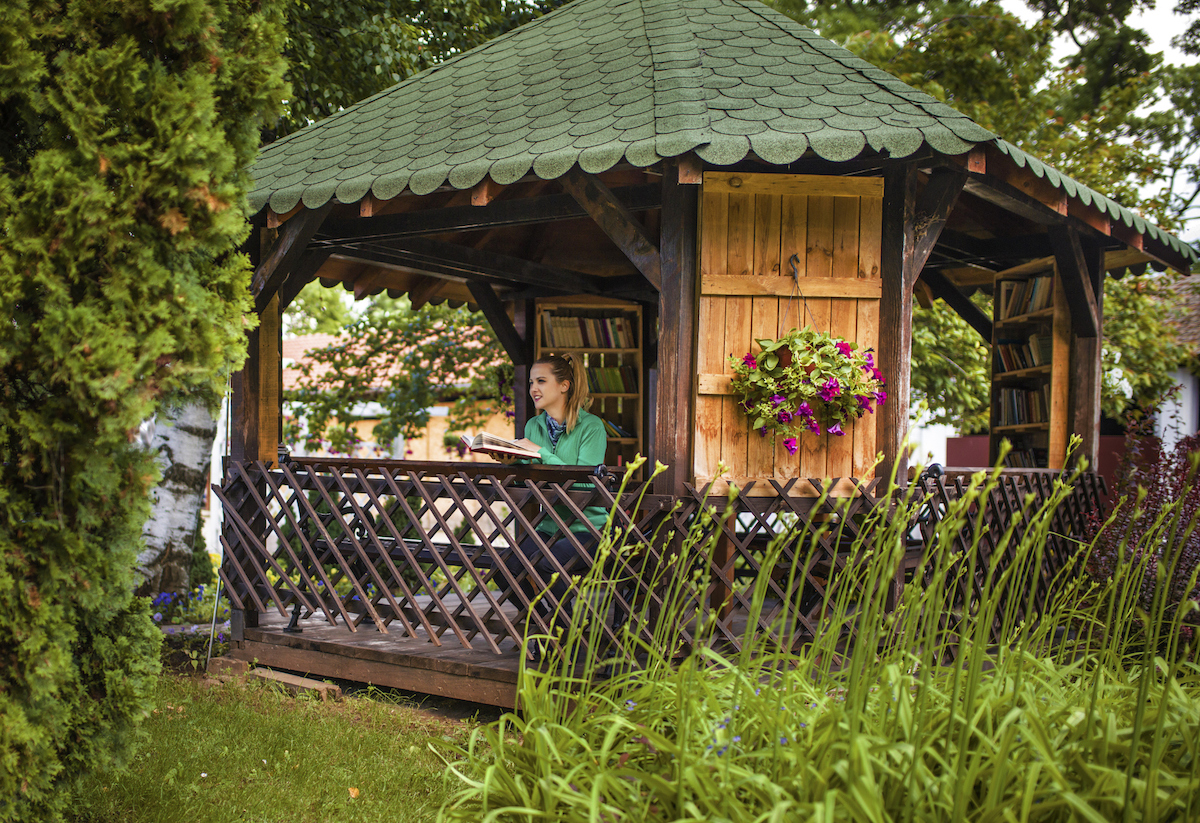

We may earn revenue from the products available on this page and participate in affiliate programs. Learn More ›
Adding a pergola or gazebo to a yard or garden creates a stylish and pleasant place to relax and spend time with family or friends. These garden structures offer shade in the searing heat of summer and, depending on the design, can protect against rain and add value to your property.
When considering the options—pergola patio, wood or metal gazebo, wood or aluminum pergola, and so many others—the endless variety can make it tough to settle on one type of structure. Choosing between a pergola vs. gazebo involves weighing factors such as timeline, budget, aesthetics, and function. This article shares the pros and cons of pergolas and gazebos to help you decide which is right for your outdoor space.
The roof design is the key difference between a pergola and a gazebo.
The main difference between a pergola and a gazebo is the roof. The roof of a pergola is typically an open grid of beams, rafters, and purlins (which run perpendicular to the rafters), usually made from wood, aluminum, steel, or PVC. While a pergola offers some shade, it provides negligible protection from rain.
Retracting fabric canopies can be added to pergolas for more shade, but a pergola canopy doesn’t provide much weather protection. Still, a pergola with a roof covering that’s semipermanent can offer greater protection from the elements. As an alternative, climbing plants can be trained to trail up the supports and twine through the roof structure, creating a green canopy that can increase shade and enhance the cooling atmosphere.
A gazebo roof, in contrast, offers complete cover. While the sides of a gazebo may be open, the roof is solid and continuous. Styles vary considerably, encompassing pagodas, tiled pavilions, modern steel-frame gazebos, fabric-topped structures, and much, much more. The roof is fixed rather than retractable and is usually pitched to allow rain to run off.
A gazebo often has a finished floor, typically slightly raised from the surrounding area. A pergola, in comparison, usually sits on an existing patio, another hard surface, or lawn. While designs vary, pergolas generally don’t include seating, while gazebos are often designed with built-in benches.
A gazebo can provide more shade and shelter from the elements than a pergola.

Given that a gazebo’s roof covers the whole structure, it is easy to assume it offers more shelter than a pergola. It may, but the amount of shelter can vary considerably. The design makes a huge difference.
Lightweight pop-up gazebos, for example, are quick and easy to erect for a party and offer protection in the event of a shower, but they’re not particularly sturdy. In inclement weather, a solid wood pergola with a canopy might provide greater protection.
However, pergolas generally aren’t enclosed, whereas gazebos often are, with options ranging from mesh screens (great for keeping the bugs out) to wooden railings to roller shutters. A permanent gazebo can offer almost complete protection from the elements, but the degree of shelter very much depends on the chosen features.
Pergola vs. gazebo: Which is right for your property?
| Gazebo | Pergola | |
| Shade | Full | Partial |
| Rain protection | Full | None |
| Cost | More expensive | Less expensive |
| DIY-friendly | No | Yes |
| Kits available | Yes | Yes |
| Has floor | Yes | Sometimes |
| Built-in seating | Usually | Rarely |
Pergolas can be attached to an exterior wall of a house.

Gazebos are stand-alone structures. While they can be placed near other buildings, they don’t rely on them for support.
Pergolas, on the other hand, often use an existing wall as one side, with the pergola’s roof structure extending out from a support plate fixed to the wall. Posts support the outer two corners. Constructing an attached pergola is not unlike adding a large porch without a solid roof.
You may not need a permit, but it’s worth checking local building codes when planning your pergola or gazebo. Size is rarely a problem, but proximity to the property line or utilities can be an issue. It’s better to check beforehand than have an official turn up after you’ve finished your project with a demand to remove it.
Pergolas are often less expensive to build than gazebos.
Those interested in a permanent garden structure usually find that a basic pergola is cheaper to build than a gazebo. “A pergola costs less to build than a gazebo just by the amount of materials needed for both structures,” says Laurel Vernazza, home design expert for The Plan Collection. “The fewer materials needed equals a lower cost to build. Additionally, home improvement stores sell DIY pergola kits, so if you are handy, you could even save on labor costs as well.”
DIY enthusiasts have access not only to a wide range of ready-to-assemble kits but also to numerous pergola plans, many of which make use of very affordable dimensional, pretreated lumber.
If a permanent structure isn’t practical or desirable, a seasonal gazebo can be a low-cost option for the garden. Keep in mind that fabric covers can last several years but tear relatively easily and may need to be replaced more often. As well, lightweight models may require stakes or weights in windy weather. Better models have much stronger, but still very light, polycarbonate roof panels. In conjunction with a steel frame, a seasonal gazebo can be a fairly rigid structure that might still cost less than erecting a pergola.
Wooden gazebo kits and plans are easy to find but are still more expensive than building a pergola of a similar size, and considerably more complex.
Both outdoor structures can add value to a home.
Anything that maximizes the use of a home’s outdoor space can make the property more attractive to buyers. The dollar value added depends to some extent on where the property is located. Homes in the Southern states, where outdoor living spans more of the year, are likely to gain greater financial benefit.
How much value does a gazebo or pergola add to a typical home? We weren’t able to find precise figures, perhaps because of the enormous range of structures and costs. However, various sources suggest a return on investment (ROI) somewhere between 50 and 80 percent, so for every $1,000 spent, $500 to $800 might be recouped when the house sells. As Vernazza notes, “Both structures add value to your home; however, a pergola typically has a better return on investment because it is so much cheaper to build.”
While adding a pergola or gazebo may not rank among the most profitable home improvements, don’t ignore the enjoyment these structures provide while you’re living in your house. Plus, when it’s time to sell, the boost to the property’s curb appeal might make all the difference, especially if your house is being compared to one without a pergola or gazebo.
Both pergolas and gazebos benefit from thoughtful placement.

Whichever type of garden structure you decide to build, evaluate the location carefully. Points to consider include:
- Where do you most need the shade and shelter of a gazebo or pergola?
- If you plan on using the structure for outdoor dining, is it convenient to the kitchen or grill?
- Does the intended location conform to the minimum setbacks required by local building codes?
- Will there be sufficient privacy?
- Does the structure make the most of desirable views, and does it enhance sightlines from the house?
- If the structure will be placed on grass, does the site offer adequate drainage and a level surface, and is it free of tree roots and other obstacles that may make it difficult to anchor the structure to the ground?
- If the garden structure will sit on concrete, how will you anchor it to the surface?
Pergolas tend to be more popular among homeowners.

“Pergolas are more popular for many reasons: They are easier and cheaper to build, can be customized to provide both shade and sun, and permits and zoning requirements are easier to obtain,” says Vernazza.
Despite their many differences, pergolas and gazebos are both attractive and versatile garden structures that enhance outdoor spaces and offer a range of design possibilities, In the end, the question of pergola vs. gazebo mostly comes down to the amount of weather protection you want—and how much you can spend on the project.


